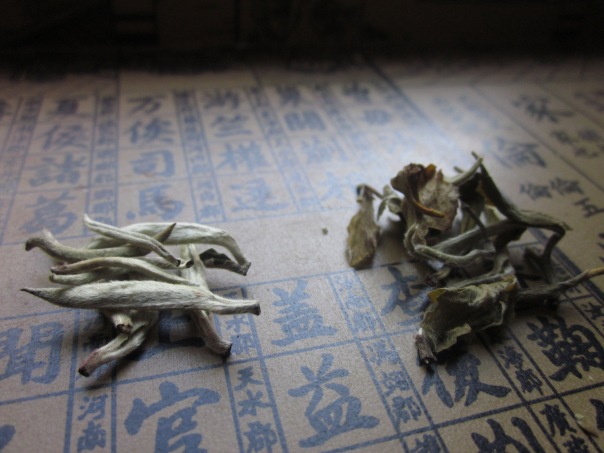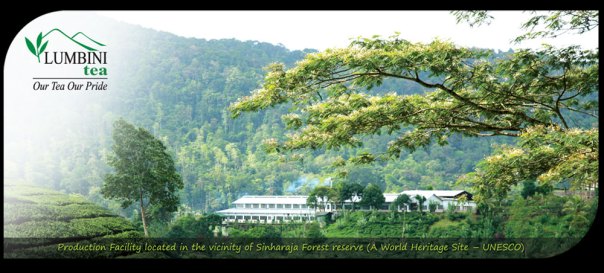-
Who would think tea professionals would ever get into disagreements that escalate into shouting matches? Certainly not I. But I’ve seen that when tea industry folks talk about white tea. I’ve even seen this at trade fairs and tea discussion panels at conventions. Thank goodness no punches were thrown—although with tea geeks like me, it probably would have been limited to ineffectual slaps? For the whole month of August TeaSource will be shining a spotlight on white teas, so this seemed the perfect time to talk about a fundamental tea difference of opinion.
Bai Hao Silver Needles Buds waiting to be pluckedFreshly plucked leaf for white tea
The first question is: what is white tea? In terms of production: white tea goes through the simplest of production processes. It begins with a unique gentle solar withering step, which can extend many hours, even into days, where they are using sunlight to help wither the leaves. Second, very limited oxidation occurs with white tea. This step is typically eliminated in the production process. But a minimal amount of oxidation occurs naturally over the course of manufacture. And thirdly, white teas typically, have no physical manipulation of the leave itself during manufacture: no rolling, twisting, panning, shaking, jiggling, caressing, tickling, etc. So stated very simplistically the production process of white is: a very long sun-wither, followed by drying. In terms of history: white tea traditionally is made in and around three small locales in Fujian province of China, the counties of Fuding, Jianyang, and Zhenghe. And naturally it would only be made from tea plants native to those locales. Some people say only tea made from those locales and those plants can be called white tea.
White tea fields in Fuding, Fujian, ChinaAnd this is where the fight begins. Is white tea defined by production process? Or is it defined by geography? This is very similar to the argument over Champagne. Does it have to be from the Champagne region of France? Or is a sparkling wine, made with the same production process the same grapes, and tasting roughly the same, but made in regions outside of France, still Champagne? I tend to not to take these kind of arguments too seriously, but to be fair this is a very legitimate question; especially for those small tea farmers in Fujian who have been making white tea for generations. All of a sudden white tea has grabbed worldwide attention and consumer interest. After more than a century of hand-making a wonderful little tea, mostly for their own local consumption, finally there is a larger demand for their product. This is their chance to get ahead. Is it right for folks who have only been making white tea for the last 5-10 years, to cash in on this sudden interest in white tea? But on the other hand these newbie white tea producers are typically using the exact same Fujian production processes, often using the Fujian tea plant cultivars, and not infrequently bringing in Fujian tea growers and manufacturers themselves to new regions to make these teas. In many cases this new white tea production has added a much needed spark to local tea industries outside of Fujian. And their white teas may look and taste as close to a Fuding white tea, as Fuding white tea tastes compared to a Zhenghe white tea. As I said, we are now in the realm of tea geeks.
TeaSource Bai Hao Silver Needles, from Fuding, Fujian, China on left, and Silver Peony White tea, from Yunan Province on right
But nonetheless this is an important question, and you should consider it as you buy white teas. You should know where you tea vendor stands on this issue, and exactly where their white teas are from. I believe the “process” defines white tea, not the geography. So TeaSource may carry white teas from many different regions. But we will always identify them when that is the case. In the past if we didn’t say otherwise we assumed people knew it was from the traditional regions of Fujian. In the future we will always try to be more specific, even about teas from the traditional areas. We hold this position (of white tea being defined by the process) because we believe the world of tea is constantly changing and evolving. And we think this is a very good thing. There are many teas that didn’t exist a few years ago. For example, Ruby 18 from Taiwan didn’t exist five years ago. White tea from Ceylon didn’t exist about 15 years ago. Shou puer didn’t exist 40 years ago. Tea from India didn’t exist 175 years ago. This kind of change and evolution is part of what makes the world of specialty tea exciting and vibrant. As with any change there are some who like it and some who are dismayed. We feel this kind of change is part of the natural processes in the world of tea. So who the heck else is making white tea? Many other China provinces, India, Sri Lanka, Taiwan, Japan, Malawi… I had the privilege to purchase the very first white tea ever produced in Sri Lanka, almost 15 years ago. I was visiting the Lumbini Estate in southern Sri Lanka (one of our favorite estates and favorite tea growing families), when Chaminda, the son of the Lumbini founder and now manager of the garden, showed me something special he had been working on, a small batch of Bai Hao Silver Needles. Needless to say his dad was very skeptical of his son’s ‘far-out” tea-making efforts. The tea was FANTASTIC. I bought all of it on the spot, about 40 kgs. When I got back into Colombo, on the way to the airport I had to stop and buy two gigantic duffle bags (think hockey equipment bags) to stuff this tea into and bring onto the plane as additional luggage. This was pre-9/11 when you could get away with this kind of thing. Although getting through Customs in Mpls, took some explaining. Unfortunately this Bai Hao Silver Needles from the Lumbini Estate has become so popular in Japan that the price has gotten out of the range of TeaSource.
The Lumbini Tea Estate in Sri LankaBefore long I think this fight about what constitutes white tea will start to fade away. For better or worse I think this horse has left the barn. The good news is that then when everyone stops talking about the definition of white tea, we will focus more on the tea itself. For white tea is a unique gift to the world of tea. The dry leaf is stunning, a botanical work of art. And the steeped cup is soft, shimmering, sweet, creamy, and evokes calm, peace, and grace. All through August we will have white teas on sale and tons of info and sampling available. And expect some additional posts about white tea.
–Bill Waddington
TeaSource, Owner
TeaSource Bai Hao Silver Needles -
After nearly six weeks of travel, I am back in Minnesota. In addition to the piles of mail on my desk, there are many packages of tea from all over the world, waiting to be evaluated. Last week, we laid out 19 different Darjeeling 2nd flush samples to cup and evaluate.Everyone always thinks this is one of the coolest things about my job, tasting teas, and sometimes it is. Yesterday, however, was not one of those days. Nineteen Darjeeling teas in a row and out of all of them there were only two remote possibilities. And even those two weren’t that great, they were only OK. That’s 90 minutes of my life I wish I had back, and boy did I have cotton-mouth. But that is a major part of my job; tasting mediocre teas, so our customers don’t have to. And it just means I have to work a little harder to find some great 2nd flushes, and I’m confident we will. We’ll keep you informed. -Bill
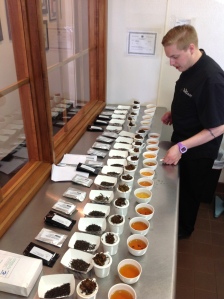
-
China has 55 recognized “ethnic minorities.” 25 of them are found in Yunnan province. So this Puer Festival was also a festival of the various ethnic minorities of Yunnan, many who have been making puer teas of their own traditions for hundreds of years. We were treated to performances, exhibitions, and meetings with members of many of these ethnic groups. One night, at an outside banquet, members of these different ethnic groups were performing. This video shows a group of young folks from the “Bai” people (excuse me if I make an error, we met a lot of folks from different ethnic groups over a short period, and I am afraid I may make a mistake on one of the group’s names). One of the wonderful things about these people is that singing (along with tea) is one of the most important activities in their culture: for them singing is a social bond, it builds community, they sing all day and evening as they work, visit, etc. It is almost impossible to overstate how vital singing is to their lives. There will be some more videos of these folks later one. These people touched my heart as much as anything did this entire trip. -Bill http://www.youtube.com/watch?v=Ta_q3oBeLj8&feature=youtu.be
View Post About Puer, China… Ethnic Minorities, Puer & Singing
-
[caption id="attachment_142" align="alignleft" width="300"]Me in the meeting place (very fancy)[/caption] About 2 hours after arriving in the city of Puer the leader of the U.S. trade delegation asked if I would participate in a meeting with Chinese trade representatives about selling more China tea, particularly puer, overseas. I went to this meeting with three other Americans and two Canadians. It turned out the meeting was not with Chinese trade representatives. It was with the very recently retired Vice-Chairman of the People’s Republic of China National Congress, Xu Jialu. Mr. Xu has also been the national congressman from Beijing for the last thirty years. To give you some perspective, his counterpart in the U.S. would be Nancy Pelosi or Tip O’Neil. So the meeting was with this one man, and his retinue which included translators, advisors, gophers, and what looked like bodyguards. There was no mistaking, this was HIS meeting. He was very gracious and explained that since his retirement he had devoted himself to helping educate the rest of the world about China, Chinese tea culture and puer tea culture, which was his great love. Since we westerners had come all the way to Yunnan, for puer, he wanted to talk to us and, in particular, pick our brains. He spoke a bit about puer and puer culture and its importance in all aspects of Chinese life. He mentioned that they were planning to do a puer tea culture demonstration in NYC with Yunnan tea masters within the next 12-18 months. He then said he would like to hear from each of us some ideas to educate our countries about puer and the beauty and benefits of Chinese tea culture (something I am an advocate of). Throughout his remarks I’m thinking, “No pressure, no pressure. Remember this guy is only Nancy Pelosi/Tip O’Neil.” [caption id="attachment_146" align="alignright" width="300"]
 Me, second to left, and Mr. Xu, in the foreground/right[/caption] Thank goodness I was the third person, so I had a few minutes to think about (and even jot down some notes) about what I would say. I would compliment them on the idea of a puer tea and culture demonstration in NYC. But, I would suggest strongly that this should just be a first step. They should also think about taking that puer tea and culture demonstration on a road show thru the U.S. After all, most of the expense was getting to North America. Don’t just do NYC. Do the west coast. Do some interior cities. I was going to ensure them that even in the interior of the U.S. there could be great interest and success in offering this demonstration. As evidence I was going to recount how just 3 weeks earlier I had brought into Minneapolis, not a large city, an international tea master to do a series of workshops, tea tastings, and demonstrations. We had reached literally hundreds of very enthusiastic and receptive attendees. (For those of you who don’t remember, in May I brought Thomas Shu to Minneapolis from Taiwan to teach). And, of course, I was going to say “international tea master”, not Taiwanese tea master. Mainland China considers Taiwan a runaway/rebellious province (illegally supported by the U.S.A. This is a very touchy subject). I even wrote down the phrase “international tea master.” I think you can see where this is going. My turn came. I thanked Mr. Xu for his kind words and welcome and for sharing his thoughts. I then mentioned I loved the idea of a demonstration in NYC, but they should think about doing this throughout America. Even in mid-sized cities, like my own Minneapolis, tea education can be very successful. Why just last month I brought to Minneapolis to teach some workshops, “an international tea master…from Taiwan…” When I heard the word “Taiwan” leave my lips my first reaction was utter shock and I thought, “Who the heck said, ‘Taiwan?” My next reaction was to reach out and try to snatch the word out of the air, like an old time cartoon character snatching a word bubble off the page. Next I tried to look at the translator to try to gesture to him to not translate “Taiwan.” But then I noticed Mr. Xu had definitely come to attention upon hearing “Taiwan.” “Oh crap.” I thought. I could also see the leader of the U.S. trade delegation turning a lighter shade of pale. Mr. Xu listened to the entire translation of my comments. Then, rather than making vague nice receptive noises, he turned, looked me squarely in the eye, and directed his comments to me personally. He thanked me for my comments, particularly for my frankness. (I’m starting to sweat bullets at this point.) He said he appreciated that I liked the idea of a tea culture demonstration and he liked the idea of doing multiple presentations throughout North America. Perhaps when they do this, if I thought it was a good idea, they could bring a tea master from Puer, Hong Kong, ….. and Taiwan to do the demonstrations. His eyes were slightly twinkling at this point, and he had a soft smile on his face. He thanked me again for my comments and gave me a slight nod. [caption id="attachment_148" align="alignleft" width="300"]
Me, second to left, and Mr. Xu, in the foreground/right[/caption] Thank goodness I was the third person, so I had a few minutes to think about (and even jot down some notes) about what I would say. I would compliment them on the idea of a puer tea and culture demonstration in NYC. But, I would suggest strongly that this should just be a first step. They should also think about taking that puer tea and culture demonstration on a road show thru the U.S. After all, most of the expense was getting to North America. Don’t just do NYC. Do the west coast. Do some interior cities. I was going to ensure them that even in the interior of the U.S. there could be great interest and success in offering this demonstration. As evidence I was going to recount how just 3 weeks earlier I had brought into Minneapolis, not a large city, an international tea master to do a series of workshops, tea tastings, and demonstrations. We had reached literally hundreds of very enthusiastic and receptive attendees. (For those of you who don’t remember, in May I brought Thomas Shu to Minneapolis from Taiwan to teach). And, of course, I was going to say “international tea master”, not Taiwanese tea master. Mainland China considers Taiwan a runaway/rebellious province (illegally supported by the U.S.A. This is a very touchy subject). I even wrote down the phrase “international tea master.” I think you can see where this is going. My turn came. I thanked Mr. Xu for his kind words and welcome and for sharing his thoughts. I then mentioned I loved the idea of a demonstration in NYC, but they should think about doing this throughout America. Even in mid-sized cities, like my own Minneapolis, tea education can be very successful. Why just last month I brought to Minneapolis to teach some workshops, “an international tea master…from Taiwan…” When I heard the word “Taiwan” leave my lips my first reaction was utter shock and I thought, “Who the heck said, ‘Taiwan?” My next reaction was to reach out and try to snatch the word out of the air, like an old time cartoon character snatching a word bubble off the page. Next I tried to look at the translator to try to gesture to him to not translate “Taiwan.” But then I noticed Mr. Xu had definitely come to attention upon hearing “Taiwan.” “Oh crap.” I thought. I could also see the leader of the U.S. trade delegation turning a lighter shade of pale. Mr. Xu listened to the entire translation of my comments. Then, rather than making vague nice receptive noises, he turned, looked me squarely in the eye, and directed his comments to me personally. He thanked me for my comments, particularly for my frankness. (I’m starting to sweat bullets at this point.) He said he appreciated that I liked the idea of a tea culture demonstration and he liked the idea of doing multiple presentations throughout North America. Perhaps when they do this, if I thought it was a good idea, they could bring a tea master from Puer, Hong Kong, ….. and Taiwan to do the demonstrations. His eyes were slightly twinkling at this point, and he had a soft smile on his face. He thanked me again for my comments and gave me a slight nod. [caption id="attachment_148" align="alignleft" width="300"]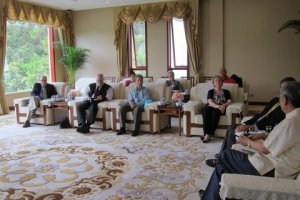 Mr. Xu in the white shirt in the center, with the leader of the U.S. trade delegation firmly planted between me and Mr. Xu[/caption] I felt like a lake trout that had been cleanly hooked, netted, and dumped into the bottom of the boat, gasping for breath; at which point the kindly, old, Chinese fisherman picked me up and gently and graciously placed me back in the water and allowed me to swim away with dignity. After the meeting I wanted to say hello and thank Mr. Xu for his time, kindness, and graciousness, but the leader of the U.S. trade delegation was going out of his way to make sure that I, and the foot protruding from my mouth, got nowhere near Mr. Xu. An interesting way to spend an afternoon when you’re exhausted, jet-lagged, and startled in a pressure situation. The good news is Mr. Xu knows who I am and might even remember me. Who knows, Minneapolis may be hosting a Chinese / puer tea culture demonstration sometime in the near future. -Bill
Mr. Xu in the white shirt in the center, with the leader of the U.S. trade delegation firmly planted between me and Mr. Xu[/caption] I felt like a lake trout that had been cleanly hooked, netted, and dumped into the bottom of the boat, gasping for breath; at which point the kindly, old, Chinese fisherman picked me up and gently and graciously placed me back in the water and allowed me to swim away with dignity. After the meeting I wanted to say hello and thank Mr. Xu for his time, kindness, and graciousness, but the leader of the U.S. trade delegation was going out of his way to make sure that I, and the foot protruding from my mouth, got nowhere near Mr. Xu. An interesting way to spend an afternoon when you’re exhausted, jet-lagged, and startled in a pressure situation. The good news is Mr. Xu knows who I am and might even remember me. Who knows, Minneapolis may be hosting a Chinese / puer tea culture demonstration sometime in the near future. -Bill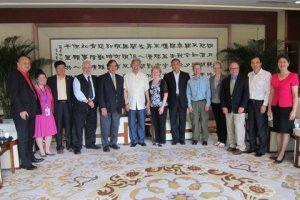
View Post About Report from Puer, China… I almost caused an international incident.
-
And with that, the 2013 World Tea Expo has come to a close. Bill, Michael, and I are all back in Minnesota, the booth has been torn down and packed away, and we're all looking forward to a really good night's sleep and to see our families again. That's not to say we didn't have a great time, and we certainly managed to make sure our last day was eventful. As mentioned in yesterday's post, Bill taught a two day course on tea processing using freshly plucked tea leaves flown in just for the class. Not only were the participants satisfied with their experience, but other WTE attendees were impressed with the logistics of getting fresh tea to Las Vegas and producing it in a convention center room. Quite the experience for everyone! Michael and I spent a little time walking the show floor and chatting with some of the other exhibitors before the Expo opened for the day. The variety of teas and tea accessories available on the market today is impressive, and it was nice to have a chance to talk to people about the growing tea markets all over the country.
 The big event of the day, however, happened at our booth. Bill brought along a portable, variable-speed bandsaw and a log of 100 Taels Dark tea which was cut into pieces right on the Expo floor. After a short talk about Dark Tea, we pulled names from a basket and gave the pieces to the winners (we were in Las Vegas, after all). About 50 people crowded around our booth, clogging the isles and generally creating a scene. It was an experience I'm not likely to forget! We didn't have time to take too many pictures while we were here, but we did get a few and we'll post them on Facebook [and the blog] in the next few days. We're already looking forward to our next trade show, so be sure to check Beyond the Leaf often to catch all of our updates! -Timothy Otte Assistant Wholesale Manager
The big event of the day, however, happened at our booth. Bill brought along a portable, variable-speed bandsaw and a log of 100 Taels Dark tea which was cut into pieces right on the Expo floor. After a short talk about Dark Tea, we pulled names from a basket and gave the pieces to the winners (we were in Las Vegas, after all). About 50 people crowded around our booth, clogging the isles and generally creating a scene. It was an experience I'm not likely to forget! We didn't have time to take too many pictures while we were here, but we did get a few and we'll post them on Facebook [and the blog] in the next few days. We're already looking forward to our next trade show, so be sure to check Beyond the Leaf often to catch all of our updates! -Timothy Otte Assistant Wholesale Manager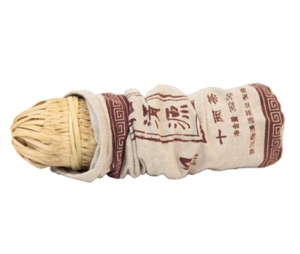
-
At the end of Day Two of the World Tea Expo I didn't feel quite as exhausted as I did after the first day. We started settling in a bit, and were able to spend some time with some of the new people who were stopping by, as well as give a little time to some of the folks who came back after saying hello on the first day. Our booth was busy all day again, but we were able to take some time to sit down and enjoy a few cups of tea before the Expo opened. Michael and I were fortunate enough to spend some time with a the producers of our new Tung Ting, Light Roast who shared some of their new and unique teas, some of which were only plucked in mid-May. It was an excellent, relaxing way to start out the day. While Michael and I relaxed, Bill was busy teaching once again. Yesterday was the first day of a two part class on tea processing. The class is an experiential lab that Bill is co-teaching with Donna Fellman, the Online Education Manager for World Tea Media. They have flown freshly plucked tea leaves that about 60 participants are using to make 5 different types of tea–white, green, yellow, oolong, and black. Today, the last day of the Expo, the participants will be finishing their tea and tasting their handiwork. Our booth was busy, but less frantic than the first day, so we were able to spend a little more time talking to people, answering questions, and sampling teas. Once again, Bill snuck off to the North American Tea Championships Winner’s Tasting Circle to feature Big Red Robe Supreme, a beautiful strip-style oolong. We're very excited about all of our teas that were honored by the judges! Today is shaping up to be another busy day here in Las Vegas! Not only will we still have a rotating selection of Taiwanese teas to sample alongside our featured teas, but we'll be making a bit of a scene on the show floor. If you're here at the Expo, stop by our booth at 1:30 for a talk on Dark Tea, as well as a rare opportunity to see a log of Dark Tea cut into cakes (don't worry, we have safety glasses). We'll be raffling off the pieces and you must be present to win. If you don't win, however, we do sell the cakes pre-cut! We'll have one final post from Las Vegas tomorrow morning after the show has ended and we're on our way home, so stop by Beyond the Leaf again tomorrow! -Timothy Otte Assistant Wholesale manager





